St Margaret’s Church, King’s Lynn (since 2011 designated The Minster) has a very imposing west window above the main entrance.
The church was originally built because a holy man sinned by inappropriately spending money and was told by a pope to spend even more money to get forgiveness. Then it was named after a saint whose exploits were considered unlikely even in the C5th. (See The Sinner and The Dragon.)
The west window continues with the apparent contradictions. Everything is not what it seems. And while initial appearances may deceive, at the same time the window gives a clear and useful message for the modern day visitor.
The West Window: It Looks Old
It certainly looks old.
If he were alive today, Oliver Cromwell could well have recognised the stonework of this window from when he was here in 1643.
During the Siege of Lynn on 3 September 1643, a preacher in St Margaret’s, Mr Hinson, had to stop his sermon when a cannon ball came though the west window and hit a pillar. Thankfully nobody was hurt but people rushed out of the church in a confused manner, some leaving their hats and scarves and books.
The window’s stonework that the Parliamentarian cannon ball pierced was the window’s original frame. Despite the repairs after the siege and modern care and restoration in 1989, the stone frame dates from the C15th.

Photo © Fr Lawrence Lew, O.P. 2021
The Clue That It Isn’t Old
The frame is old, and the religious-looking subject matter on the glass painted in a medieval style combine to give an initial impression that the glass too might be old.
However, the glass isn’t original and the design isn’t old. It was designed by Donald B. Taunton working for the John Hardman & Co. (the company closely associated with Pugin). The glass dates from 1927.
There is a clue in the window that tells us that the glass is not C15th. The glass was paid for by Colonel Thomas Johnson Seppings and his cousins (members of a local brewing family). Seppings died in 1925.
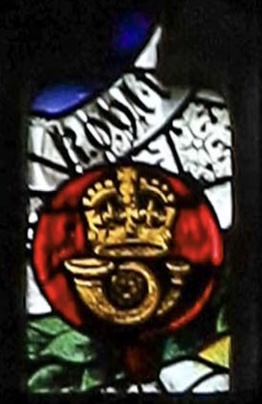
In the top left of the window is a circle divided into quadrants. The bottom right quadrant contains a crown, a bugle, and the letters K.O.Y.L.I. – the emblem of the King’s Own Yorkshire Light Infantry. Seppings was a Colonel in this regiment which was formed in 1881. We are being reminded of the man who paid for the glass and told that it is not medieval.
King’s Lynn History Revision Guide
Despite conflicting structural messages about its age, the window is giving clear information about the history of King’s Lynn. As is appropriate for a church, Christ is central and the middle panels surround him with angels. However, flanking these are important figures in the history of King’s Lynn. The window acts as a kind of mini King’s Lynn History Revision Guide.
King John and King Henry: Bottom Row
The bottom row (the one most accessible to people standing below and looking up) contains characters and describes events pivotal in the Lynn’s development. It depicts Lynn receiving its charters from King John and from King Henry VIII.

Bottom Row, Left Window
In 1204 the Bishop of Norwich, John de Grey, obtained a charter from King John, enabling Lynn to become a free borough.
A grant in 1206 gave the burgesses of Lynn a guild merchant and general liberties according to the customs of Oxford.

Bottom Row, Second from Left Window
King John gives the Mayor of Lynn a ceremonial sword. Unfortunately It wasn’t entirely spelled out what Lynn could and couldn’t do, and there were frequent trips to Oxford and Norwich as town leaders tried to work it out.
The other complicating factor was that the the rights of the bishop and the earl of Arundel over the town were also maintained. The town was still known as Bishop’s Lynn. This ambiguity inevitably led to occasional conflict between the parties (see The Riot when Bishop Henry Despenser came to Lynn).
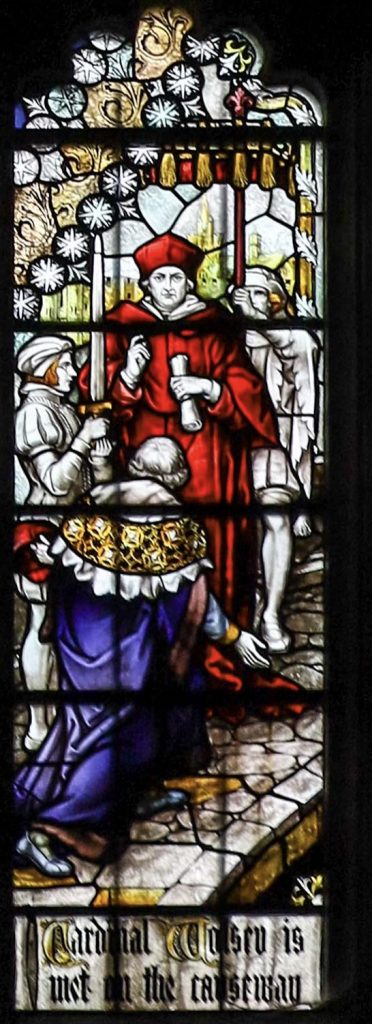
Bottom Row, Second from Right Window
Cardinal Wolsey visited Lynn in 1520. He was met by the Mayor and Corporation at the bishop’s manor at Gaywood. His warm welcome helped the town during the long-running dispute between the town and bishop over the authority of the Mayor.
Bottom Row, Far Right Window
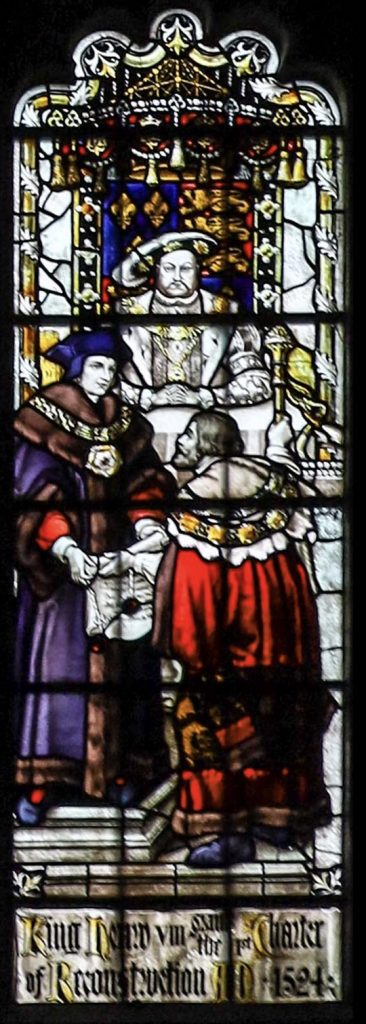
Henry VIII gives Lynn a new charter in 1524 and it becomes known as King’s Lynn.
Key King’s Lynn Characters: The Top Circles
In the top third of the window, on the left and right side, are two circles, each divided into quadrants. Each quadrant contains an emblem referencing important people or groups in the town’s past.

Left Circle, Top Left Quadrant
Corpus Christie Guild. Lynn had over 50 Guilds, and Corpus Christie was the third largest. Its Guild Hall no longer exists, but was in King Street.

Left Circle, Top Right Quadrant
The Guild of the Holy and Undivided Trinity was the largest guild in the town. Its Guildhall sits near the church.

Left Circle, Bottom Right Quadrant
The emblem of Colonel Sepping’s regiment. See above
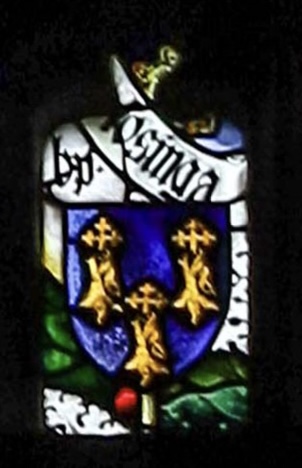
Left Circle, Bottom Right Quadrant
The emblem of Bishop Herbert de Losinga who founded the church in 1101. Read The Sinner and The Dragon for more of his story and for an explanation of the Dragons’ heads and the crucifixes.

Right Circle, Top Left Quadrant
King John gives the town its first charter enabling it to become a free borough at the beginning of the C13th.

Right Circle, Top Right Quadrant
Henry VIII gives the town its second charter in the C16th.
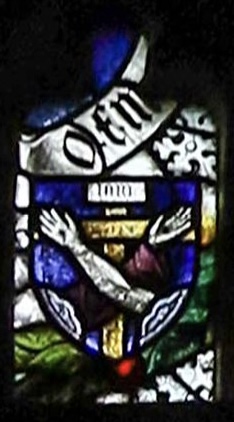
Right Circle, Bottom Right Quadrant
The emblem of the Franciscan Friars. The remains of the town’s Franciscan Friary (Greyfrairs) is near the church at the top of St James’ Street.
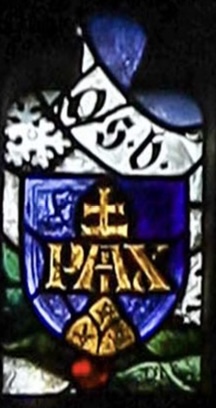
Right Circle, Bottom Left Quadrant
The emblem of the Benedictine Priors. St Margaret’s was founded as a Benedictine Priory Church.
Key King’s Lynn Saints: Middle Row
The middle row depicts many of the saints associated with Lynn: St Edmund, St Nicholas, St John, Virgin Mary, St Margaret, St George.

Middle Row, Top Left Window
St Edmund, King of East Anglia. He was martyred by the Danes in 870. St Edmund had a medieval church in North Lynn which stood by the old Dow Chemical site. The new St Edmunds building on Seabank in North Lynn is no longer used as a church.

Middle Row, Bottom Left Window
St Nicholas, Bishop of Myra in present day Turkey. He is the patron of sailors. His chapel of ease in the town (St Nicholas) is the largest chapel of ease in England, paid for by local merchants with a vested interest in the sea. It ceased to function as a church in 1989.
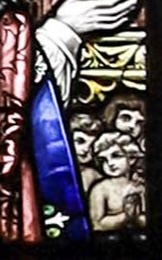
Shown with St Nicholas are three boys, pickled for meat during a time of famine, and brought back to life by the saint.

Middle Row, Second From Left Window
St John, the Evangelist.
St John’s Church was built in Lynn in 1845. The pews in St Margaret’s and St Nicholas were owned by the well-to-do and many didn’t use them regularly. St John’s was built to provided capacity for all who wanted to attend an Anglican Church. Without pew restrictions, Methodism had experienced rapid growth at this time.

Middle Row, Second From RIght Window
The Virgin Mary.
Historically Lynn was an important stopping off post on the way to the Shrine at Walsingham which was established at the end of the C11th. Lynn also had two chapels dedicated to Our Lady (Ladybridge and Red Mount).
The Roman Catholic Church of St Mary was rebuilt in London Road in 1897 and for a while it had served as the Shrine of Our Lady in lieu of Walsingham.

Middle Row, Far Right Bottom Window
St Margaret
St Margaret is the patron saint of the church and she is holding a model of the church in her hands.
Margaret was born a pagan during the reign of the Roman emperor Diocletian (284–305), but became a Christian through the nurse who brought her up as her own mother had died after Margaret’s birth. When she was 15 she refused to give up her faith and marry Olybrius. He had her imprisoned and tortured.
In one of her tortures Satan appeared to her disguised as a dragon and then swallowed her up. However, Margaret was able to use her cross to irritate Satan’s stomach and she was disgorged. She was eventually beheaded in 304.
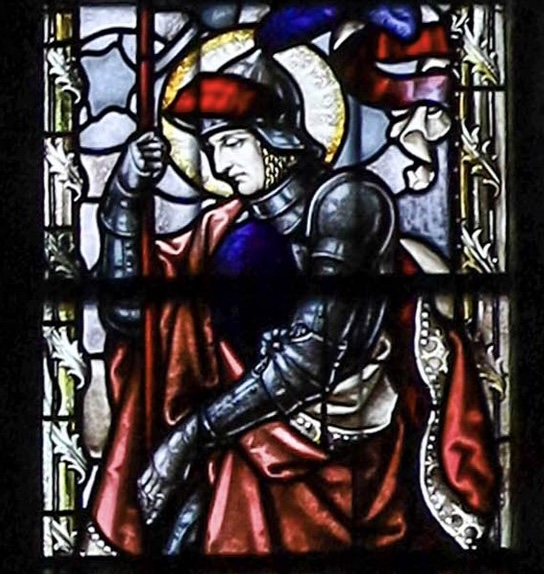
Middle Row, Far Right Top Window
St George
St George was the patron of the second largest guild in Lynn. Its guildhall (completed in 1428) stands in King Street. It is the oldest and the largest complete medieval Guildhall in England.
Leading away from the east end of the church is St James’ Street, and at the far end of St James street there used to be a St James’ Church (which was built in 1135, converted into a workhouse in 1680, fell down in 1854, and was finally destroyed in 1910). According to my understanding at the time of writing (please correct me if I am wrong) St James appears to be the obvious missing saint from the window. (The figure in the middle of the bottom row is an archangel.) Perhaps Taunton took the view that as St James’ Church no longer existed, and as they had limited window space, St James could wait for another window.
Book a Walk with a Trained and Qualified King’s Lynn Guide
© James Rye 2022
Acknowledgement
All images used in this article are taken from an original photograph of the window by Fr Lawrence Lew, O.P., used with permission.
Sources
- James, E. (date unknown) The Great West Window of King’s Lynn Minster, Leaflet, St Margaret’s Church
- https://m.geograph.org.uk/photo/5288154
- https://en.wikipedia.org/wiki/Hardman_%26_Co.
- https://www.visitstainedglass.uk/artist-page/hardman-john-co

[…] The west window of St Margaret’s Church has a bottom row featuring the key people in the history of Lynn’s name change. See King’s Lynn’s Contradictory Window. […]